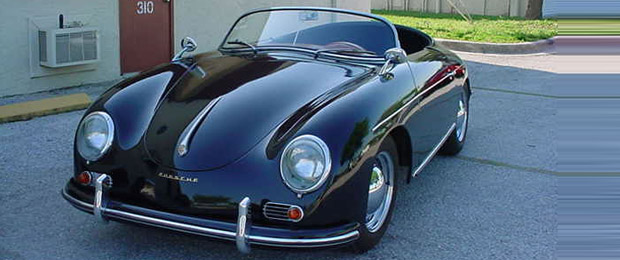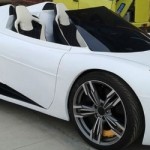 The prototypical Porsche replica on the road today is none other than the 356 or “bathtub” Porsche which made its appearance in 1956 and was, in one way or another, really just a Volkswagen with a different body.
The prototypical Porsche replica on the road today is none other than the 356 or “bathtub” Porsche which made its appearance in 1956 and was, in one way or another, really just a Volkswagen with a different body.
Today’s replica, though, is far from that vintage vehicle of more than half-a-century ago. It is true that Ferry Porsche wanted a performance vehicle that was more than just a warmed over Volkwagen (hardtop or cabriolet, it really didn’t matter). So, he did have his engine tuners take the standard 39 horsepower engine of the era and do a little tweaking here and there.
Some of the tweaking involved boring and stroking the VW powerplant so that it cranked out much more horsepower and torque. It also involved changing the gearing so that the “bathtub” had much longer legs and could handle turns and corners better.
If you remember commercials of the time, you may remember one for Volkswagen which showed a snowplow driver getting out to his rig to start plowing during a snowstorm and the question asked was simply: “How do you think snowplow drivers get to their trucks?” The answer was, of course, Volkswagens because of the fact that their engines were located in the rear over the rear wheels and they picked up all that extra weight from the engine and transxle so they could go through the snow where other cars would not tread.
They didn’t tell you about some of the problems that these cars faced such as as the rear equivalent of torque steer (the VWs and Porshes of the era had this tendency to fishtail to the left when you hit the gas hard and since they were air-cooled and the cooling systems were never notoriously efficient, they couldn’t go very fast, unless, of course, the factory tuners or tuner shops got their hands on them and rerouted some of the cooling intake ducts for better engine cooling, but that’s another story). The fact is that the 356 was the tuned version of the VW and that pretty much told the story, other than the fact that Ferry Porsche wanted his 356 to run like a scalded rodent and handle as if there was not different between the light front end and heavy rear end.
Ferry got his wish but it did take some doing and if you are lucky enough to have one of those original cars in good shape, take good care of it because it is worth its weight in oil (that’s a pretty potent commodity today) — okay gold, is good, too, because you have a vehicle that will easily pull mid to high six-figure or seven-figure results at auction. Remember, though, it has to be in showroom shape.
If you want to be seen driving one that looks like the original 356 you might try a 356 like those made at Specialty Auto Sports in Knoxville, TN.
Try as you might, you will not be able to have a vehicle — even a replicar kit — certified for street use today due to the air pollution and safety standards that cars have to meet today to gain certification. That’s why Specialty Auto borrows the frame and chassis from a Subaru and uses that as the basis of its 356 replica.
Today’s regular Porsche owner is in luck because the original air-cooled engine went the way of the big fin in the late 1950s. It just disappeared into the dust of automotive history. Instead, Porsche (and VW) began using water-cooled powerplants in the mid-1970s and the rest (as the story goes) is history. Horspower went up, body styles changed and vehicles that were once pretty tame actually became performers. Even the VW TDI (fuel-injected diesel) took on new life. (The original diesels from VW couldn’t get out of their own way, even if you were running outside pushing downhill with a tailwind. Or to put it another way, if you made it to more than 12 mph in first you were really grinding the heck out of the powerteam and you had to upshift until you hit about 19 and then you had to hit it again. They weren’t the most vigorous vehicles in the world. Enter the turbocharger and the entire face of the Golf TDI changed for the better. It could actually perform!
Specialty Auto goes them a whole lot better by using the driveline from the original Subaru — depending on the chassis you’ve chosen you can have an engine that will crank out anywhere from 170 to 300-plus horsepower).
The 356 replica is a mid-engined vehicle with a slight rearward weight bias (45/55) so most of the weight is still over the rear wheels and if you don’t watch it, you can still pop the rear end to the left if you let the clutch out a little too quickly.
The Specialty Auto chassis uses the rack-and-pinion steering you find in the Subaru chassis and it also takes advanged of the four-wheel disc brake system and anti-lock braking. Actually, for a 356 replica whose interior is excellent, by the way, the handling is pretty neutral, though you can induce the 356 to do doughnuts on a snowy parking lot if you know what you are doing).
The bodywork on the Specialty Auto replica is quite good as all of the seem line up quite well and the fit and finish are tight. If you were to peel back the skin, you’d notice that the build team at Specialty does do a bit of work with reinforcing the frame with key spot welds and you would also know that if you put the original side-by-side with the replica you’d find the replica is wider with deeper foot wells and there’s more headroom, too boot. You also have greater range with a 16-gallon fuel cell.
Finally, the best thing about this — or any of the other quality replicas such as those that are made by Beck — is that they are street legal so you can drive them wherever you’d like to go.
If you were to have an original 356, it would be street legal because all of the vehicles from the 1950s and 1960s are grandfathered so they are automatically street legal. The only problem is that if you owned an orignal and it cost you $500,000 or more, do you think you’d actually drive it down the street?
Image: bobsclassics.com






Leave a Reply
You must be logged in to post a comment.